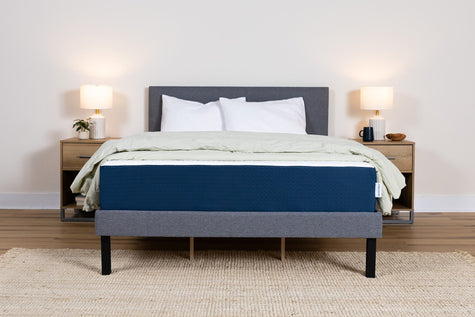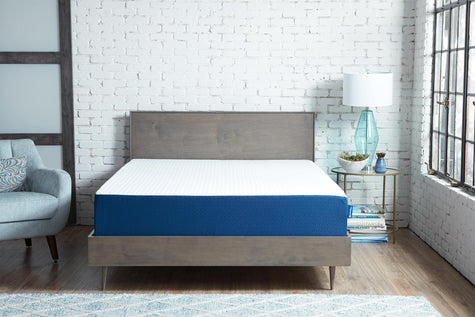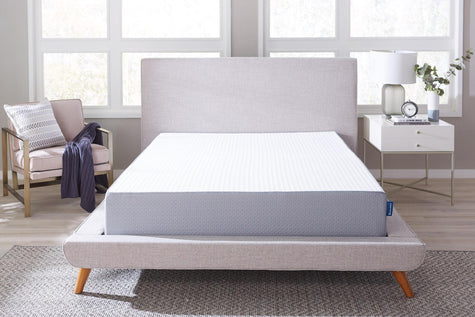Density & Softness

We are going to introduce you to the two main characteristics of memory foam. They are density and softness. They may sound similar but they are not the same.
Density merely describes the weight of the foam, not the amount of 'softness or support', this is measured by IFD (Indentation Force Deflection), The higher the IFD, the more firm the foam is, regardless of density. So it is true that a less dense foam CAN be more supportive than a heavier density foam. Additionally, density does not describe the durability of a foam as many people think. Read on for a more detailed explanation of these two measurements.
All of our mattresses feature CoolRest® Visco-Elastic Memory Foam, which is the perfect combination of density and softness. Below we will define these characteristics.
Density - Density is weight per unit volume.
In other words, the weight is divided by length times width times height (volume) and is generally expressed in the U.S. as lbs/ft3 (pounds per cubic foot - pcf). For example, if you have a cube of memory foam 12 inches long, 12 inches wide and 12 inches high, you have one cubic foot of memory foam. If this cube weighs three pounds, you can say that you have three pounds per cubic foot of memory foam. You can also say that the density is three pounds or that you have three-pound density memory foam.

Density can be obtained from any sample size. Density is not related to pore size (the size of the little holes in the foam) since coarse or larger pore foams and fine pore foams can have equal densities. Density is not related to firmness, softness or the ability to support weight. Density is usually equated with durability but that depends on who is making the foam and their level of commitment to creating a quality product.
There is such a thing as too much density. The main complaint of memory foam mattress owners is that the foam gets too hot or that it takes too long to rebound when turning over – interrupting sleep. These are the direct results of too much density. Mattresses with 5 lb. density and greater are commonly cited as being too gooey when warmed by the body and exhibit the problems just cited. Another reason higher density foams perform poorly is because of older memory foam technology.
*** If a company is using outdated foam technology, their foam will stiffen when left in an area cooler than 60 degrees. Our foam will not stiffen.
High quality, American-made 3 lb. to 4 lb. density memory foam is probably the best all-around density for a mattress because it is durable, builds up less heat and rebounds more quickly and smoothly to keep from waking you up.
Our memory foam is a BASF creation which is a special type of new generation memory foam that is designed to provide the perfect blend of Density and softness. Our foam also has a broader temperature range which means it does not get hard when the ambient air temperature cools below 60 degrees and does not get gooey when the ambient air temperature goes above 90 degrees.
What about Memory Foam Softness and Firmness?

Firmness, softness and memory foam's ability to support weight is determined by Indentation Force Deflection (IFD) or Compression Force Deflection (CFD). Deflection is another way of saying how much something "gives". Indention Force Deflection is a fancy way of saying, "how much pressure it takes to mash it down".
Indentation Force Deflection (IFD) (previously called Indention Load Deflection, ILD) is a test method to determine load bearing capacity (firmness or stiffness), and is measured in pounds of force required to smash the foam down 25% of its original height.
For example: To obtain the IFD of any memory foam, a circular indenter plate is driven down into a 15" x 15" x 4" foam sample, stopping when it reaches a deflection of 1", 25% of the original 4-inch thickness.
The testing device records the force in pounds required to hold this foam indented after one minute. The higher the force reading, the firmer the foam. If it takes 10 lbs. of force to smash the foam down 25% of the original height, the IFD or "softness" of the foam is said to be 10 or "soft". If it takes thirty pounds, the foam is said to be firm and fifty pounds or more is considered very firm.
Three fatigue tests are:
1. Static Fatigue:
Measure the 25% and 65% IFD values. Deflect to 75% of the original thickness and keep deflected for 22 hours. Relax the foam for 30 minutes. Then retest IFD at 25% and 65% deflection points and calculate force loss.
2. Roller Shear Fatigue:
A stainless steel roller is used to dynamically fatigue a sample of foam for 8,000 or 20,000 cycles in 5 hours or 12 hours respectively. IFD values are also compared before and after fatiguing and a percent loss of load bearing capability is calculated.
3. Constant Force Pounding Fatigue:
A flat horizontal indenter foot is used to fatigue a foam sample for 8,000 cycles in 2 hours, or 80,000 cycles in 19 hours. IFD values at 40% deflection are compared before and after fatiguing and the percent load loss is calculated.
Memory foam density and softness numbers may not necessarily be a good way to determine memory foam quality. The chemicals which are used to make memory foam can vary greatly from manufacturer to manufacturer and even from "pour" to "pour".
The U.S. is currently being flooded with Chinese memory foam that is supposed to have adequate density such as "5.3lb" but which tends to exhibit poor characteristics. These characteristics include slowness to rebound, getting harder as the room temperature gets cooler, heat build-up after laying on it for a while and chemical smells. These smells are often caused by chemicals and take a very long time to dissipate from the mattress and may be harmful and even carcinogenic. There are no regulations on the purity and safety of Chinese or any other memory foam. Even though it is inexpensive, there may be a health price to pay.
What about the Foam under the Memory Foam?
The foam under the memory foam is just as important as the memory foam itself. Once you have sunk down into the memory foam and it has conformed to your body, you need good support foam to catch your bones. We use "high resilience" support foam that is similar to the foam in a car seat. It is durable, yet comfortable and supportive. A lot of memory foam mattress companies cut corners and use low quality support foam to increase their profit. Many of the low price mattresses you see on the market have inferior quality support foam under the memory foam.
We use only HR support foam with a rating of 24/32. That means a 2.4 lb density with a 32 IFD. In this industry, most manufacturers will consider our support foam "overkill" in the quality department. We decided to pay more and charge less for a mattress that we know will last and provide superior support for your body.
Why do we do it? Because we believe that everyone deserves to have this mattress and get a great night's sleep at an affordable price.
Conclusion
Density is measured as the weight of foam. When it comes to density, bigger (a higher number) is not necessarily better. There is a happy medium between a foam's density, its durability and feel (which is all determined by who makes it and how). Softness is determined by how much weight the foam can bear. Soft foam is best if you have High Resiliency support foam to "catch" your bones after you sink into the memory foam.
We hope this has been helpful. If you have any questions, contact us through Customer Care.



